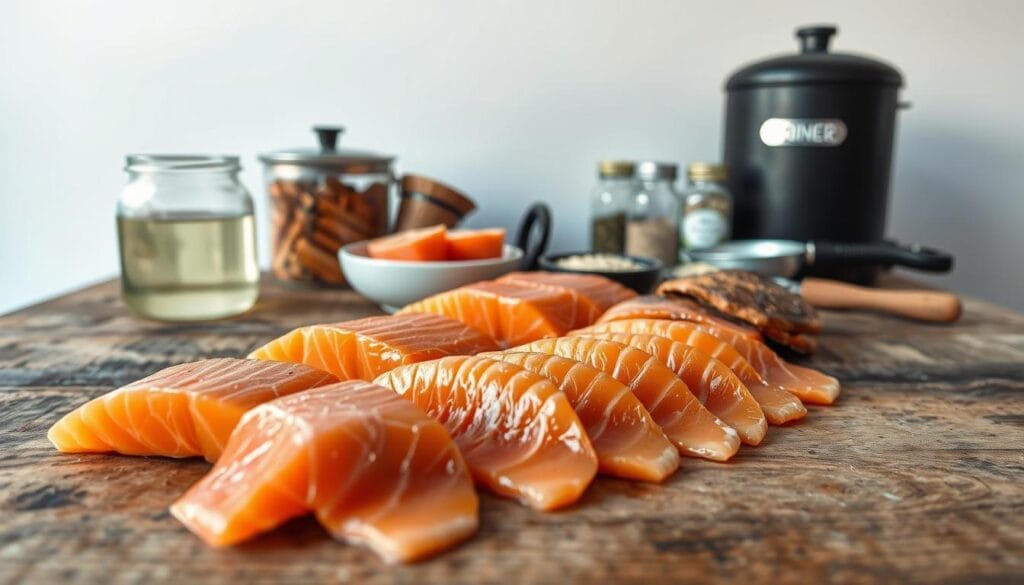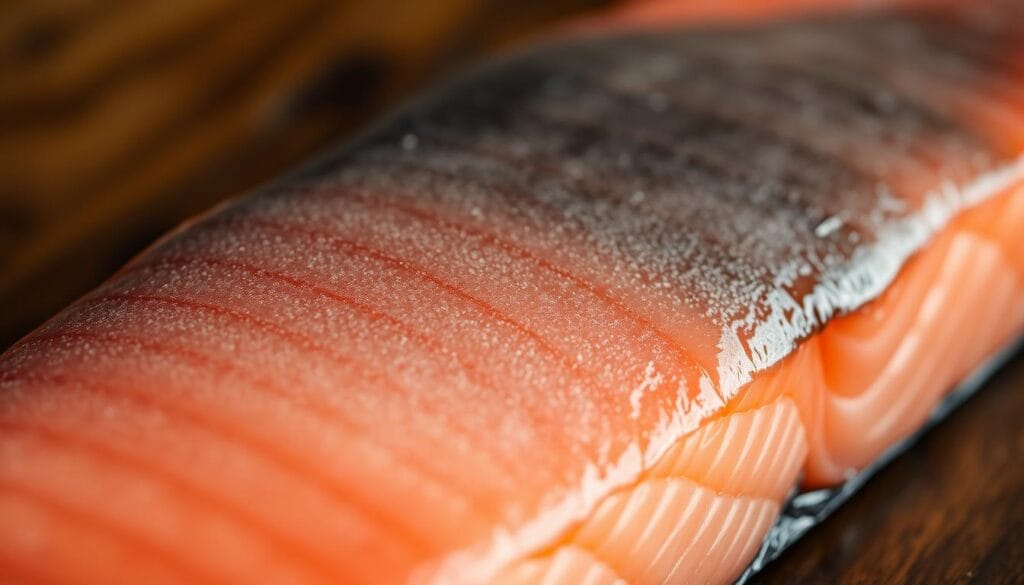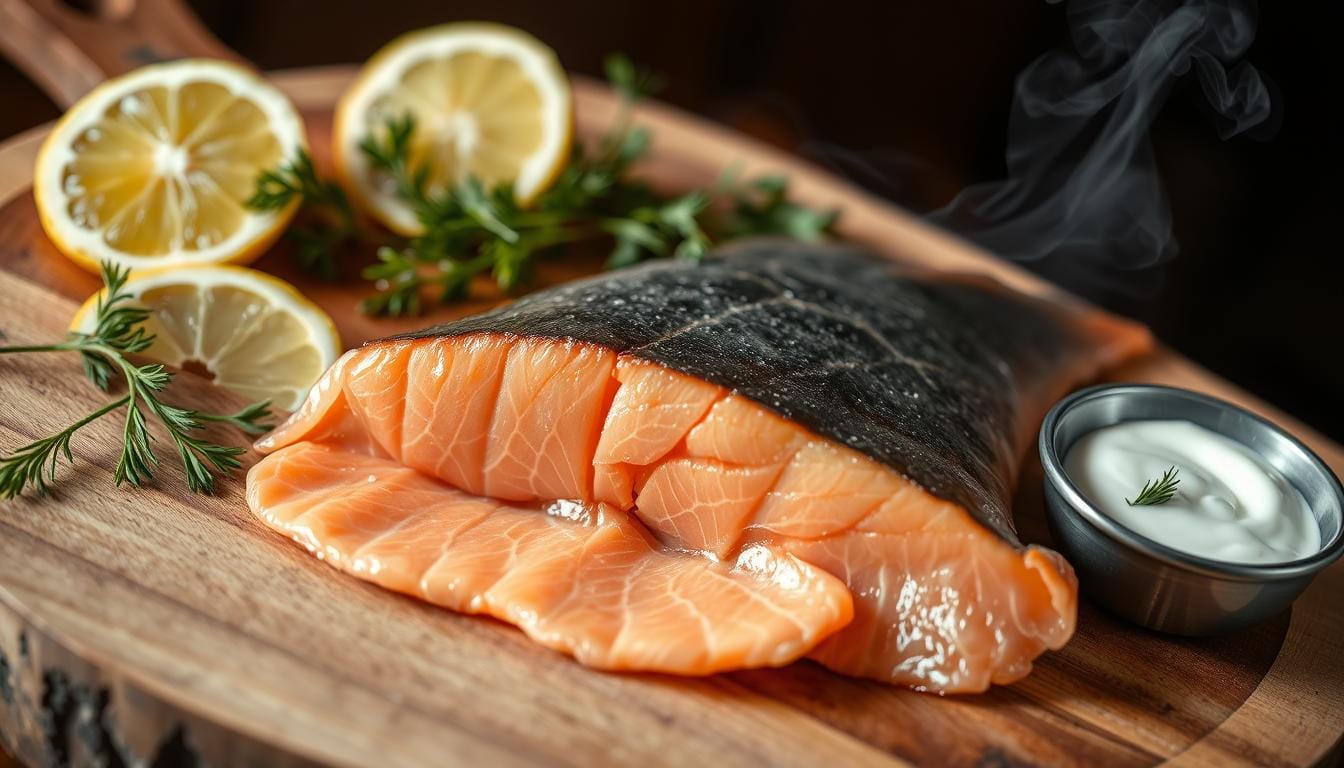Making Cold Smoked Salmon Safely – Tips and Method Explained
Table of Contents
The first time I tasted cold smoked salmon, it was a game-changer. The silky texture and smoky flavor took me to coastal kitchens. Making it at home might seem hard, but with the right steps, you can make it a gourmet treat.
Cold smoked salmon is a culinary art that needs precision and patience. It keeps the fish’s raw texture while adding smoky flavors. Both chefs and home cooks have learned to make it safe and tasty.
This guide will show you how to make cold smoked salmon. You’ll learn about choosing the best salmon, smoking techniques, and keeping it safe. Whether you love cooking at home or are a culinary fan, these tips will help you make top-notch cold smoked salmon.
Creating cold smoked salmon requires careful attention. You need to control temperatures, follow curing steps, and use the right tools. By using professional methods, you can make a dish that’s as good as any seafood restaurant.
Understanding Cold Smoked Salmon Basics
Exploring salmon preservation reveals a unique culinary technique. It turns fresh fish into a gourmet treat. Cold smoking is an art that needs precision, skill, and a grasp of food science.
What is Cold Smoking?
Cold smoking is a special way to preserve salmon. It cures the fish and smokes it at low temperatures. This method keeps the salmon raw, unlike cooking.
The key is to keep temperatures below 90°F. This lets the fish soak up smoky flavors without cooking.
“Cold smoking is more about flavor infusion than cooking – a delicate dance of temperature and technique.”
Cold Smoking vs Hot Smoking
It’s important to know the difference between cold and hot smoking. Here’s a quick comparison:
| Characteristic | Cold Smoking | Hot Smoking |
|---|---|---|
| Temperature Range | Below 90°F | 120-180°F |
| Cooking Status | Raw | Fully Cooked |
| Texture | Silky, Soft | Firm, Flaky |
Traditional vs Modern Smoking Methods
Is smoked salmon raw? It depends on the method. Ancient ways focused on survival, while modern ones aim for flavor and safety. Today, we use advanced temperature control and precise curing for gourmet smoked salmon.
- Traditional methods relied on salt and smoke for preservation
- Modern techniques use controlled environments
- Scientific understanding ensures food safety
Whether you’re a food lover or a home cook, knowing these basics will improve your salmon smoking skills.
Essential Equipment and Tools for Cold Smoking
Learning to smoke salmon without a smoker can seem tough. But with the right tools and a bit of creativity, you can make tasty salmon at home. Cold smoking needs special tools to control temperature and add smoky flavors to your salmon.
- Digital thermometer for precise temperature tracking
- Cooling racks for proper air circulation
- Vacuum sealer for preservation
- Wood chips or sawdust for smoke generation
Exploring ways to smoke salmon without a smoker? Here are some ideas:
- Outdoor grill with indirect heat
- Makeshift smoke chamber using a cardboard box
- Electric hot plate with wood chips
“The right equipment transforms an amateur cook into a smoking enthusiast.” – Culinary Expert
For those without smokers, improvisation is key. A basic setup with controlled temperature and quality wood chips can make your salmon taste like it’s from a restaurant.
Choosing the right wood is important for that smoky taste. Alder, apple, and cherry woods are great for salmon. Each wood adds its own special flavor to your dish.
Selecting the Right Salmon for Cold Smoking
Choosing the perfect salmon is key to making cold smoked salmon. The quality of your fish affects the flavor, texture, and success of your smoking project.
Not all salmon is the same when it comes to cold smoking. Your choice can greatly impact the smoking process.
Best Salmon Species for Smoking
Different salmon species have unique qualities for cold smoking:
- King (Chinook) Salmon: Highest fat content, rich flavor
- Atlantic Salmon: Consistently available, excellent fat marbling
- Sockeye Salmon: Leaner option with deep red color
Fresh vs Frozen Salmon
Fresh salmon might seem like the best choice, but high-quality frozen salmon can be just as good. Commercially frozen fish is often flash-frozen at peak freshness, keeping its quality.
Quality Indicators to Look For
When picking salmon for cold smoking, look for these quality signs:
- Bright, consistent color without brown or gray patches
- Firm flesh that springs back when touched
- Clean, ocean-like smell without strong fishy odors
- Minimal liquid in packaging
Farm-raised Atlantic salmon usually gives the best results for cold smoked salmon. It has high fat content, making it luxurious in texture and flavor.
Making Cold Smoked Salmon: Step-by-Step Process
Learning to make smoked salmon needs precision and careful technique. The cold smoking process turns fresh salmon into a delicacy. It has rich, delicate flavors that keep the fish’s tender texture.

To make smoked salmon, you must follow a detailed approach. Begin by picking high-quality salmon. Make sure it’s clean and trimmed properly.
- Clean and fillet the salmon carefully
- Prepare the brining solution
- Create a salt and sugar cure mixture
- Allow salmon to cure for the specified time
- Rinse and pat dry the fish
- Develop the pellicle through air drying
- Set up a cold smoking environment
- Smoke at low temperatures
Your brining solution is key to making smoked salmon safely. The right mix of salt and sugar preserves the fish. It also boosts its flavor.
| Step | Temperature | Duration |
|---|---|---|
| Curing | 38-40°F | 12-24 hours |
| Pellicle Formation | 50-60°F | 2-4 hours |
| Cold Smoking | 70-90°F | 6-12 hours |
Experts say keeping temperatures steady is vital. It ensures food safety and the best flavor in cold smoked salmon.
The Science Behind Brining and Curing
Cold smoked salmon needs a careful brining and curing process. This turns raw fish into a tasty treat. The steps involve complex chemical reactions that affect taste, texture, and safety.
Learning about cold smoked salmon preparation is key. It helps you make a product that’s both tasty and safe.
Salt and Sugar Interactions
The salt-to-sugar ratio is very important for cold smoked salmon. This mix does several things:
- It pulls moisture out of the fish
- It stops bacteria from growing
- It makes the flavor better
- It creates a protective layer
Chemical Processes During Curing
Curing starts amazing chemical changes in salmon. Salt gets into the fish’s cells, making it hard for bad bacteria to live.
“Curing is both an art and a science in cold smoked salmon preparation.” – Culinary Expert
Temperature Control Techniques
Keeping the brining temperature just right is key for cold smoked salmon. Keeping it between 36-40°F stops bacteria and helps flavors develop well.
| Brining Parameter | Recommended Range |
|---|---|
| Salt Concentration | 3-5% |
| Sugar Ratio | 1-2% |
| Brining Temperature | 36-40°F |
By understanding these scientific steps, you can make cold smoked salmon that’s both safe and delicious.
Wood Selection and Smoke Generation
Choosing the right wood is key when making smoked salmon. The wood you pick can make your salmon truly special.
Alder wood is the top choice for smoking salmon, mainly in the Pacific Northwest. Fruitwoods offer delightful alternatives that can take your smoking to the next level.
- Alder: Traditional and mild flavor
- Apple wood: Sweet and subtle taste
- Maple: Gentle and slightly sweet smoke
- Cherry: Rich and fruity undertones
The wood you choose greatly affects the taste of your smoked salmon. Each wood brings its own flavor that pairs well with the fish.
There are several ways to generate smoke:
- Traditional wood chips
- Compressed wood pellets
- Electric smokers with integrated wood chip trays
Pro tip: Start with small amounts of wood and gradually increase to find your perfect smoke intensity.
Keeping the temperature steady is important. Aim for a low temperature of 70-90°F. This ensures your salmon gets that smoky taste without getting overcooked.
Safety Considerations and Temperature Control
When making cold smoked salmon, knowing about food safety is key. Is smoked salmon raw? Not really, but it needs careful handling to avoid bacterial growth and ensure it’s safe to eat.
Cold smoking doesn’t fully cook the fish. So, you must follow strict safety rules to avoid foodborne illnesses.
Critical Control Points in Salmon Preparation
It’s vital to identify and manage critical control points in cold smoked salmon. These stages need careful attention:
- Initial fish selection and quality inspection
- Precise temperature monitoring
- Proper brining and curing techniques
- Consistent low-temperature smoking
- Immediate refrigeration after smoking
Preventing Bacterial Growth
Bacterial contamination is a big risk with cold smoked salmon. To reduce this risk, keep temperatures in check:
- Keep fish below 40°F during preparation
- Limit time at ambient temperatures
- Use precise refrigeration techniques
- Monitor for histamine-forming bacteria
Safe Storage Guidelines
Proper storage keeps your cold smoked salmon fresh and safe. Refrigerate it right after smoking and eat it within the suggested time frame.
“Food safety isn’t expensive, it’s priceless” – Unknown Food Safety Expert
By sticking to these guidelines, you can enjoy tasty homemade cold smoked salmon safely. This way, you protect yourself and your loved ones from foodborne risks.
Creating the Perfect Pellicle

Making cold smoked salmon requires a perfect pellicle. This tacky layer on the fish’s surface is key for smoke absorption and safety. It’s a critical step that can greatly affect your final product.
To achieve the perfect pellicle, start by drying your salmon with paper towels. Remove any extra moisture. Then, let the fish air-dry in a cool, well-ventilated area for a few hours. This step makes the surface proteins sticky, ready to catch smoke particles.
- Ensure the room temperature is between 50-60°F
- Use a fan to improve air circulation
- Allow 2-4 hours for pellicle formation
- Check for a slightly shiny, tacky surface
The science behind pellicle formation is interesting. As the fish dries, proteins on the surface coagulate. This creates a thin layer that attracts smoke molecules. This layer not only adds flavor but also seals the fish from bacteria during smoking.
“A perfect pellicle is the secret to professional-quality cold smoked salmon” – Seafood Smoking Experts
Look for signs of a well-formed pellicle. The salmon’s surface should be slightly shiny and feel sticky. If it’s too wet or dry, your smoke absorption and texture might suffer.
Storage and Preservation Methods
Storing cold smoked salmon correctly is key to keeping it fresh and safe. Learning the best ways to preserve it lets you enjoy it for months after making it.
Keeping the salmon at the right temperature is essential. Aim for 38°F (3.3°C) if the salt content is low or the water activity is high. This temperature stops bacteria from growing and keeps the salmon’s flavor intact.
- Refrigeration: Store cold smoked salmon in the coldest part of your fridge
- Vacuum sealing: This method keeps air out and extends its shelf life
- Use airtight containers to block moisture and keep it clean
Freezing is great for long-term storage. Wrap your cold smoked salmon tightly in plastic wrap or vacuum-sealed bags to prevent freezer burn. Frozen, it can stay good for up to three months.
“The key to preserving cold smoked salmon is protecting it from air, moisture, and temperature fluctuations.” – Seafood Preservation Expert
Look out for these signs of spoilage:
- Unusual odor
- Slimy texture
- Discoloration
- Mold growth
By sticking to these storage tips, you can enjoy your homemade cold smoked salmon safely. It will also keep its delicious taste and texture.
Conclusion
Cold smoking salmon is an art that mixes cooking skills with food safety. It doesn’t matter if you use a smoker or not. The main thing is to know the basic techniques to make fresh fish into a tasty treat.
Learning to cold smoke salmon takes patience, precision, and a focus on quality. You need to pick the right salmon, make a perfect pellicle, and control the temperature. You can even smoke salmon without a smoker by using a cold smoking box or setting up your kitchen.
Cold smoking salmon is more than just following steps. It’s about creating a special experience. By learning about salt ratios, wood types, and curing, you’ll improve your cooking skills. And you’ll make smoked salmon that’s as good as what you find in restaurants. Always keep food safety in mind to make sure your dish is both tasty and safe.
As you try different salmon types and smoking methods, you’ll grow to love this old technique. Your homemade cold smoked salmon will impress your friends and family. It will show off your new skill in this delicate cooking art.
FAQ
Is cold smoked salmon raw?
How long can I store homemade cold smoked salmon?
Can I make cold smoked salmon without a professional smoker?
What are the best types of salmon for cold smoking?
Is homemade cold smoked salmon safe to eat?
What wood types work best for cold smoking salmon?
How long does the cold smoking process take?
Do I need to use a salt cure when making cold smoked salmon?
Did You Try Our Recipe?
There are no reviews yet. Be the first one to write one.

